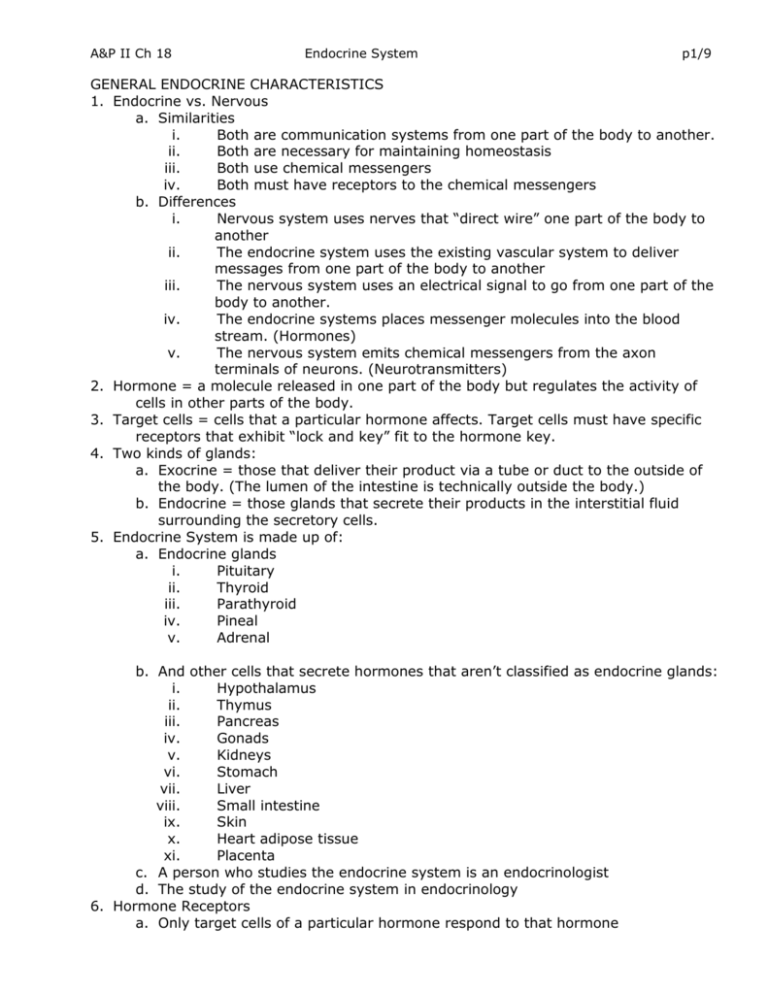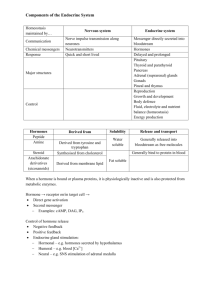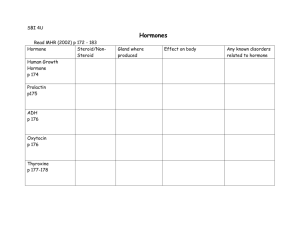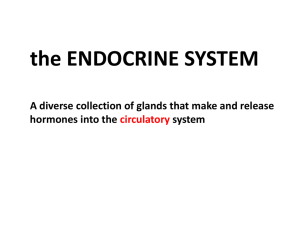1 - Morgan Community College
advertisement

A&P II Ch 18 Endocrine System p1/9 GENERAL ENDOCRINE CHARACTERISTICS 1. Endocrine vs. Nervous a. Similarities i. Both are communication systems from one part of the body to another. ii. Both are necessary for maintaining homeostasis iii. Both use chemical messengers iv. Both must have receptors to the chemical messengers b. Differences i. Nervous system uses nerves that “direct wire” one part of the body to another ii. The endocrine system uses the existing vascular system to deliver messages from one part of the body to another iii. The nervous system uses an electrical signal to go from one part of the body to another. iv. The endocrine systems places messenger molecules into the blood stream. (Hormones) v. The nervous system emits chemical messengers from the axon terminals of neurons. (Neurotransmitters) 2. Hormone = a molecule released in one part of the body but regulates the activity of cells in other parts of the body. 3. Target cells = cells that a particular hormone affects. Target cells must have specific receptors that exhibit “lock and key” fit to the hormone key. 4. Two kinds of glands: a. Exocrine = those that deliver their product via a tube or duct to the outside of the body. (The lumen of the intestine is technically outside the body.) b. Endocrine = those glands that secrete their products in the interstitial fluid surrounding the secretory cells. 5. Endocrine System is made up of: a. Endocrine glands i. Pituitary ii. Thyroid iii. Parathyroid iv. Pineal v. Adrenal b. And other cells that secrete hormones that aren’t classified as endocrine glands: i. Hypothalamus ii. Thymus iii. Pancreas iv. Gonads v. Kidneys vi. Stomach vii. Liver viii. Small intestine ix. Skin x. Heart adipose tissue xi. Placenta c. A person who studies the endocrine system is an endocrinologist d. The study of the endocrine system in endocrinology 6. Hormone Receptors a. Only target cells of a particular hormone respond to that hormone A&P II Ch 18 Endocrine System p2/9 b. The target cells contain a receptor molecule c. When the hormone chemically bonds with the receptor it alters the action of the cell having the receptor d. A target cell may have between 2000 and 100,000 receptors for a particular hormone. i. The cell can alter the number of receptors available to hormone binding and alter its sensitivity to that hormone 1. If the cell removes receptors and becomes less sensitive then the cell has down-regulated. 2. If the cell adds additional receptors and become more sensitive then the cell has up-regulated. ii. Various drugs act by: 1. Binding to a receptor without activating it, thereby, blocking the true hormone from binding and activating the cell. 2. Binding to a receptor and activating a cellular process. 3. Binding to a receptor and inhibiting a cellular process. 4. Binding to a hormone so that it no longer fits the receptor site iii. Cell often up-regulate or down-regulate and change their response to drugs, making the drugs less effective over time. 1. Drug dosage may be adjusted as time goes on 2. Some drugs require a period of abstinence periodically to allow the cell to return to normal receptor density 3. Example: Nicotine binds to nicotinic acetylcholine receptors and stimulates the cells. A smoker initially over stimulates cells with nicotinic acetylcholine receptors. The cells are being stimulated by both the normal acetylcholine present and by the nicotine. The cells respond by removing some receptors and reducing the stimulation back to normal function. When a smoker quits smoking the cells have been down-regulated and respond at reduced stimulus levels because they now have only the available acetylcholine. 7. Types of hormones a. Most hormones are circulating hormones. b. Other hormones are local hormones. i. Local hormones include paracrine hormones 1. Produced by cells that affect nearby cells ii. Local hormones include autocrine hormones 1. Produced by cells and the hormone stimulates itself or only adjacent touching cells. 8. Chemical classes of hormones a. Lipid soluble (not soluble in water like oil and vinegar salad dressing) i. Must be bound with a carrier globulin protein to make them water soluble for transport in the blood. 1. It is released from the carrier before entering the cell ii. Can mix freely with other lipids like the phospholipid cell membrane iii. Can freely pass through the cell membrane iv. Has receptors inside the cell v. Steroid hormones derived from cholesterol are lipid hormones. 1. Sex hormones 2. Corticotropic hormones vi. Other Lipid hormones A&P II Ch 18 Endocrine System p3/9 1. Thyroid hormones made from the amino acid tyrosine which has a lipid soluble benzene ring. 2. Nitric Oxide gas hormone b. Water soluble i. Can not freely pass through the hydrophobic cell membrane ii. Has receptor on the cell membrane. 1. Transmembrane protein receptor 2. Glycoprotein receptors iii. May be further classified as 1. Amine hormones made from amino acids with the carboxyl group (COO) removed. a. Epinephrine b. Norepinephrine Catecholamines c. Dopamine d. Histamine e. Serotonin f. Melatonin 2. Peptide Hormones a. Hormones that are a short string of amino acids connected by peptide bonds. (Depending on the book either < 100 or this book < 50) 3. Protein Hormones Longer chain of peptide bonded amino acids. a. Protein hormones with an attached carbohydrate group are called glycoprotein hormones. 4. Eicosanoid Hormones a. Twenty carbon chain of fatty acid produced from arachidonic acid which is made from a membrane phospholipid. b. Two types of eicosanoid hormones i. Prostaglandins – first discovered in the prostate, later found throughout the body ii. Leukotrienes – immune system communicators 9. Hormone Action a. The same hormone may do different things in different places. i. Example: Insulin Removes glucose from the blood by: 1. Increasing facilitated transport into cells. 2. Increasing triglyceride production in adiposities (making fat) 3. Increasing glycogen production in hepatic cells (liver storage of energy) b. Lipid Hormone action i. Lipid hormones are released from their carrier ii. Hormone diffuses from the blood into the interstitial space iii. Lipid hormones diffuse through the phospholipid cell membrane to find their receptor in the cytoplasm or inside the nucleus. iv. It turns on or off specific genes c. Water soluble hormone action i. Hormone diffuse from the blood into the interstitial space ii. Hormone binds to a receptor on the cell membrane A&P II Ch 18 iii. Endocrine System p4/9 The hormone is called the first messenger because it activates a 2nd messenger system. Cyclic AMP 2nd messenger system iv. The first messenger activates a G protein within the phosphate heads of the plasma membrane. v. A portion of the G protein (α,β,or ) travels in the membrane between the phosphate heads and activates Adenylate cyclase vi. Adenylate cyclase changes ATP into cAMP vii. cAMP activates protein kinase viii. The protein kinase causes an ATP to phosphorylate a protein 1. The protein is usually an enzyme 2. Phosphorylation may activate the enzyme 3. Phosphorylation may inactive the enzyme ix. The phosphorylated protein alters the cellular function by turning on or off a specific metabolic pathway in the cell x. Phosphordiesterase inactivates the cAMP Calcium 2nd messenger system xi. The first messenger activates a G protein xii. A portion of the G protein opens a Ca2+ channel in the membrane xiii. The Ca2+ binds and activates calmodulin xiv. Calmodulin activates a protein kinase which phosphorylates an enzyme xv. The enzyme turns on or off a metabolic pathway in the cell There are other 2nd messenger systems, but these two are principal 2nd messenger systems. d. Amplification of hormone effects. i. Hormones are difficult to detect and quantify in the blood because they exist in minute quantities. ii. Their effect is amplified by the target cell after binding to the receptor 1. Example: a. One hormone molecule binds to a receptor b. The receptor activates 100 G proteins c. Each G protein activates an adenylate cyclase d. Each adenylate cyclase molecule can activate 1,000 cAMP making 100,000 activated cAMP’s from one hormone molecule. e. Each cAMP can activate 1,000 phosphate kinase molecules making one million activated phosphate kinase molecules from a single hormone molecule. e. Interaction between hormones i. A target cell’s response to a hormone depends on: 1. Concentration of the hormone 2. Number of specific receptors available to the hormone 3. Interaction by other hormones. a. Permissive effect – When the hormone action depends on simultaneous or recent exposure to a 2nd hormone. A&P II Ch 18 Endocrine System p5/9 b. Synergistic effect – when the combination of two hormones produces an effect greater than the sum of the two hormones acting alone. c. Antagonistic effect – when one hormone opposes the action of another. f. Control of hormone secretion – Hormone secretion is regulated by: i. Signals from the nervous system can stimulate or inhibit hormone release ii. Chemical changes in the blood varies the amount of hormone released 1. Feedback systems a. Positive feedback – when the release of a hormone causes even more of the same hormone to be released. Example – Oxytocin b. Negative feedback – when the release of a hormone causes a decrease in the production of the hormone as the desired level is reached. 2. Chemical shifts cause by external factors such as food intake, exercise, etc. iii. Other hormones can stimulate or inhibit the release of a hormone SPECIFIC ENDOCRINE GLANDS 1. The master gland a. Many glands secrete their hormone in response to hormones released from the pituitary gland. For years the pituitary gland was called the “master gland” b. The pituitary only secretes its controlling hormones when stimulated by the hypothalamus. Therefore, the pituitary is not actually considered the master gland by most endocrinologists. c. The hypothalamus portion of the brain integrates neural and endocrine system responses. 2. Hypothalamus – lower portion of the diencephalon part of the brain a. Contains nuclei with cell bodies that are influenced by other brain signals b. Contains sensors that sense, body temperature, blood pH, blood osmolarity, etc. c. Communicates with the pituitary with neural signals and by hormones it produces. 3. Pituitary – sits in the sella turcica of the sphenoid bone a. Attached to the hypothalamus by the pituitary stalk = infundibulum i. The infundibulum contains the pars tuberalis – the tube portion extending up from the anterior pituitary, and ii. The axons between the hypothalamus and the posterior pituitary. iii. The hypophyseal portal system is a specialized circulatory system between the hypothalamus and the anterior pituitary 1. A capillary bed (primary plexus) in the hypothalamus absorbs hormones from the hypothalamus. 2. The capillary bed combines into a vein along the infundibulum 3. The vein fans back out into a capillary bed (secondary plexus) among the glandular cells of the anterior pituitary delivering the hypothalamic hormones to the anterior pituitary. b. The pituitary consists of i. Posterior pituitary 1. contains axon terminals whose synaptic vesicles contain the posterior hormones A&P II Ch 18 ii. Endocrine System p6/9 2. Instead of synapsing on another neuron, muscle or gland as most axon terminals the synaptic vesicles exocytosis their contents into posterior pituitary interstitial space to be absorbed into capillaries and carried to all parts of the body by the blood stream. 3. The posterior pituitary is therefore, made of neural tissue type. 4. The posterior pituitary is also called the Neurohypophysis. 5. The terminal vesicle products are actually produced in cell bodies located in nuclei of the hypothalamus. The cellular products are transported by axonal transport to the terminal vesicles just as in any other neuron. 6. The posterior pituitary only secretes two hormones. a. Oxytocin – this hormone causes uterine contraction for giving birth (parturition), and causes the release of milk from the breasts of lactating mothers. b. ADH (Antidiuretic hormone) this hormone causes the kidneys to conserve water in the body. i. The hypothalamus contains sensors that sense the direction of push of osmotic pressure. 1. When the blood becomes concentrated water wants to flow by osmosis from the hypothalamus into the blood. This is called high blood osmotic pressure. 2. When the blood becomes dilute water wants to flow by osmosis from the blood into the hypothalamus. This creates and osmotic pressure in the opposite direction and is called low osmotic pressure of the blood. ii. ADH is also called vasopressin. It can raise the blood pressure by increasing the volume of the blood. The more volume you force into a closed system the higher the pressure in that system The anterior Pituitary = Adenohypophysis Glandular epithelial tissue 1. Derived from the same embryonic tissue as the epithelial lining of the roof of the mouth. 2. Secretes 7 hormones. 3. Control of secretion of anterior pituitary is through the action of 6 hypothalamic hormones. A&P II Ch 18 Endocrine System p7/9 Hypothalamus: (Releasing Hormones) Crazy CRH Corticotropin Releasing Hormone Sisters Give Somatostatin GHIH Growth Grief GHRH Hormone Inhibiting Hormone GnRH Growth Hormone Releasing Hormone To People Thyrotropin Releasing Hormone Prolactin Releasing Hormone TRH Gonadotropin Releasing Hormone PRH Pituitary: (Stimulating Hormones) Most Good Melanocyte Stimulating Hormone human Growth Hormone MSH hGH People Always Love Their Families Prolactin (Dopamine) Adrenal Corticotropic Hormone Lutenizing Hormone Thyroid Stimulating Hormone Follicle Stimulating Hormone PRL ACTH LH TSH FSH Body: Brain & Skin All Cells Mammary Adrenal Cortex Gonads Thyroid A&P II Ch 18 Endocrine System p8/9 THYROID GLAND 13.In the neck 14.Two lobes 15.Connected with a strip of gland called the isthmus 16.Cell types a. Thyroid Follicle Cells i. Secrete T3 (Triiodothryonine) and T4 (Thyroxine) b. Parafollicular cells (C cells) i. Secrete calcitonin 1. Decreases level of Ca in the blood 2. Inhibits osteoclasts 3. Increases uptake of Ca and P into bone 4. Miacalcin – a calcitonin extract from salmon used to treat osteoporosis b/c it is 10 X strength of human calcitonin. PARATHYROID GLANDS 17. Located on the back of the thyroid gland 18. Most people have 4 19. Secrete parathyroid hormone a. Major regulator of the levels of Ca2+ and Mg2+ in the blood b. Increases the number and activity of osteoclasts c. Decreases HPO42- in the blood d. Converts Vitamin D to Calcitriol i. Calcitriol increases rate of absorption of Ca2+ by the intestines ADRENAL GLANDS 20. Located on top of each kidney like a little hat 21. Actually 2 separate glandular functions in each gland a. Medulla – modified peripheral ganglion surrounded by the adrenal cortex i. Secretes mostly epinephrine but ~ 20% Norepinephrine, also called adrenaline and noradrenaline ii. Also secretes a small amount of dopamine, also a catecholamine iii. Responds to the autonomic sympathetic nervous stimulus iv. Enhances the fight-or-flight response of the body b. Cortex Glandular epithelial tissue i. 3 regions 1. Zona Glomerulosa – secretes mineralocorticoids a. Principal mineralocorticoid is aldosterone i. Aldosterone regulates the Na+ and K+ balance ii. Promotes excretion of H+ to reduce acidity iii. The more salt in the blood the more water comes in by osmosis, therefore more blood volume and more blood pressure. iv. If blood pressure drops: 1. Kidneys release renin 2. Renin converts angiotensinogen produced by the liver into angiotensin I 3. ACE (angiotensin converting enzyme mostly from the lungs) converts angiotensin I to angiotensin II. 4. Angiotensin II stimulates a. Adrenal cortex to release Aldosterone A&P II Ch 18 Endocrine System p9/9 b. Aldosterone increases Na+ in the blood which increase osmotic pressure and increases blood volume, which increases blood pressure. 5. Angiotensin II also increases blood pressure while waiting for more blood volume by constricting arterioles 2. Zona Fasciculata – Secretes glucocorticoids including cortisone a. Cortisone is a steroid that i. inhibits inflation ii. inhibits the immune system iii. helps resist stress iv. stimulates lipolysis v. Gluconeogenesis vi. Protein breakdown – muscle atrophy 3. Zona Reticularis – secretes weak androgens DHEA a. Increases sex drive b. Can be converted into estrogens c. Males have some estrogen from the adrenal cortex d. Females have some testosterone from the adrenal cortex PANCREAS 22. (More to Come)








